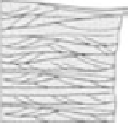Geoscience Reference
In-Depth Information
3
Low-angle
cross-
stratified
sandstone
Texturally mature;
clean; very well sorted
quartz-rich fine-
grained to medium-
grained; incipient
continuous mudstone,
silt or heavy-mineral
drapes
Sharp lower and upper
boundaries, set
boundaries distorted;
bed thickness
> 2.5 m, lateral extent
< 100 m, bedset
thickness < 10 m
Unbioturbated (0);
rare local high
intensity (5)
Deposited by waves
and/or storms in
shoreface; possible
swaley cross-
stratification
3B of tidal channel infill
4A of wave-dominated
shoreface
4B of wave-dominated
shoreface
4
Cross-stratified
sandstone
with
mudstone
drapes
Fine-grained to very
coarse; well to poorly
sorted; continuous
rhythmic single and/
or paired mudstone
or siltstone drapes
along normally graded
tabular to tangential
and sigmoidal
foresets; mudstone/
siltstone/plant debris,
drape thickness
and abundance
vary rhythmically;
opposite oriented
flow cross-laminae on
bottomsets; mudstone
rip-up flakes in toesets
oriented parallel
with bottomsets; rare
mudstone rip-up clasts
and floating clastic
granules; glauconite
grains
Erosional lower
boundary; upper
boundary either
gradational and
upward fining or
sharp and erosive;
abundant to rare set
bounding accretion
surfaces; abundant
internal reactivation
surfaces; bed
thickness 0.1 m up
to > 4.2 m, lateral
extent several 10s
to several 100 m;
tabular to lensoid
geometries
Coarse fraction:
sparse
Ar, Di, Op
,
Sk
, rare to common
Belemnite rostra
1
;
low intensity (0 to
2). Fine fraction:
Pl
and worm
traces, oyster
shell fragments;
moderate
intensity (3 to 4);
Unbioturbated (0)
Deposited by
migration of small
to giant single and
complex fluvial to
sub-tidal 2D and 3D
dunes, bars in wide
high energy tidal
or tide-dominated
fluvial channels;
from mid-channel/
thalweg bars to
heterolithic foreset
portion of sub-tidal
compound dunes
and distributary
mouthbars;
Deposited by
migration of small
complex 3D tidal-
fluvial dunes on
top of sub-aqueous
or exposed mouth
bars or on top of
tidal-fluvial side
attached bars
1B of fluvial-tidal transition
1C of fluvial-tidal transition
2A of tidal inclined
heterolithic strata
3A of tidal channel infill
3C of tidal channel infill
3D of tidal channel infill
4A of wave-dominated
shoreface
2B
†
of tidal inclined
heterolithic strata
2C
†
of tidal inclined
heterolithic strata
5C
†
of mixed tide- and
wave-influenced
heterolithic delta
7A of wave-dominated
open-marine
5
Compound
cross-
stratified
sandstone
with
mudstone
drapes
Fine-grained to
medium-grained;
systematic double
mudstone drapes;
drape thickness and
abundance alternate
rhythmically; low-
angle to high-angle
cross-stratification;
rare mudstone clasts
parallel on foresets;
ripple laminae on
bottom sets; rare iron
ooid-rich beds
Erosive upper and
lower bounding
accretion surfaces;
abundant accretion
surfaces, reactivation
surfaces separate
individual sets; bed
thickness 0.2 to
1.0 m
Heterolithic member:
unidentified
burrow traces,
Th
;
moderate intensity
(2 to 3).
Sandy member: low
intensity (0 to 1).
Deposited by
migration of
complex dunes
in relatively deep
high energy tidal
channels with
diurnal bipolarity
of current; iron
ooids eroded
on land and
transported in the
sand fraction
2A of tidal inclined
heterolithic strata













Search WWH ::

Custom Search